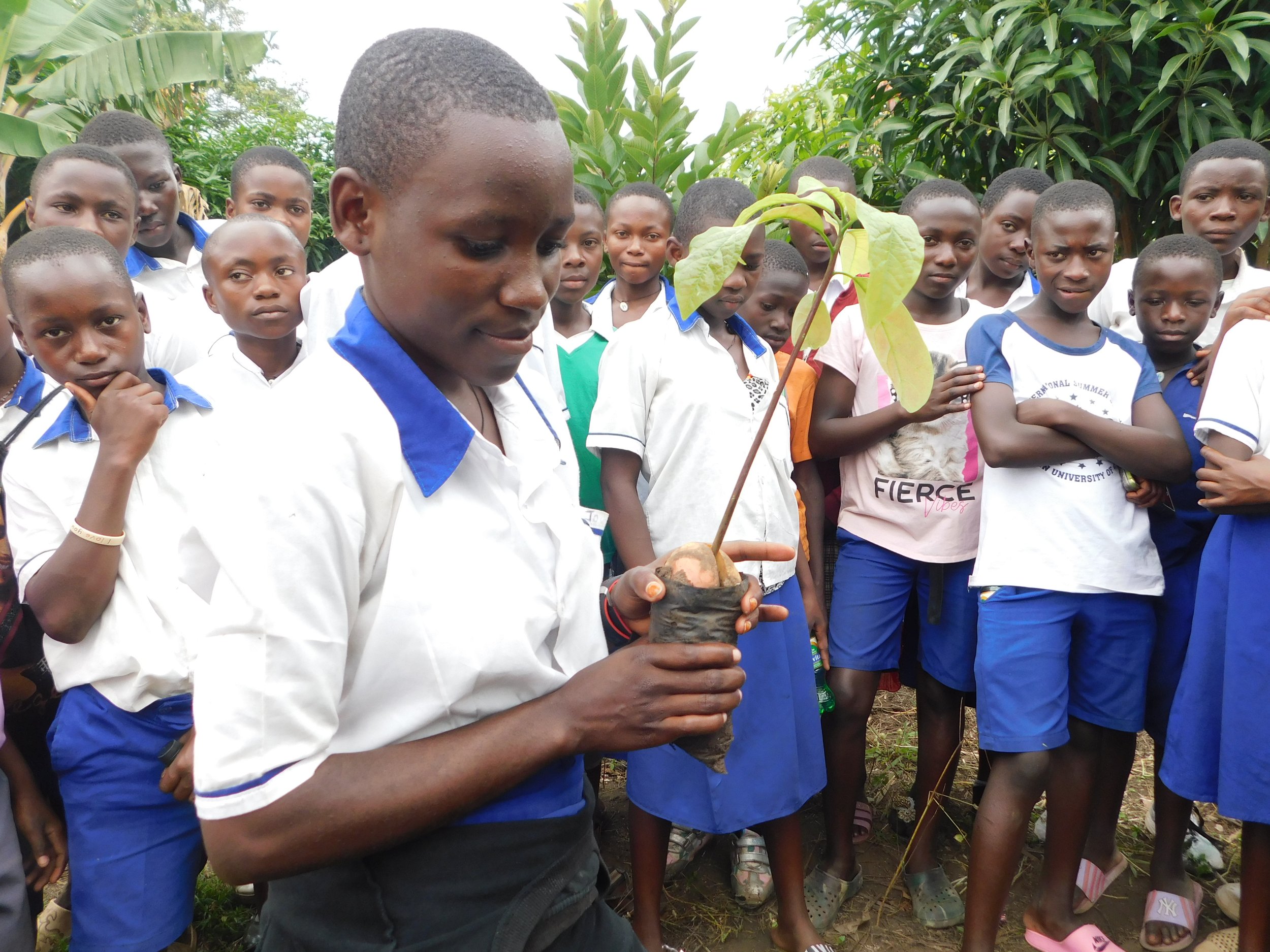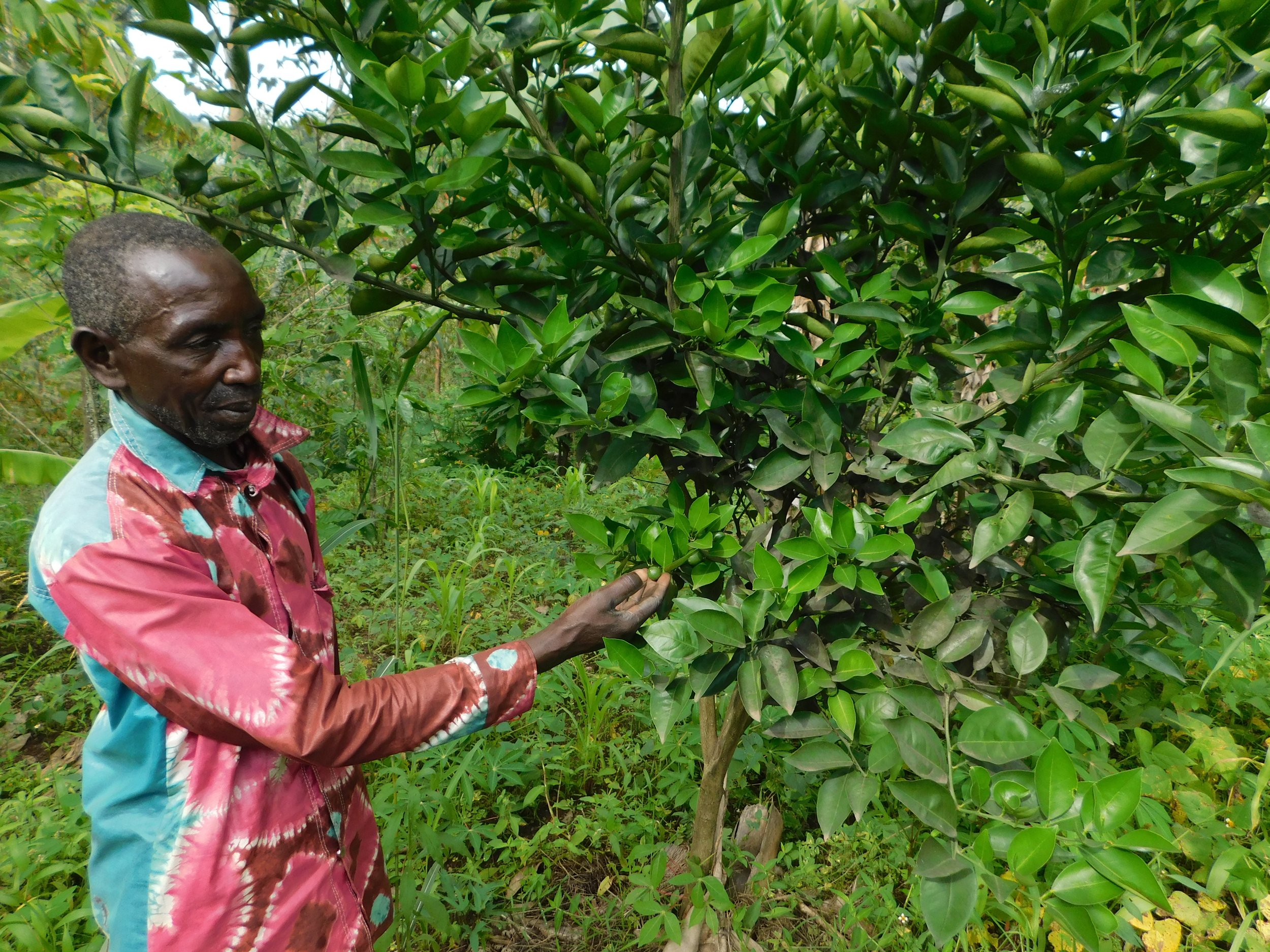Trees that empower
Since 2020, we’ve been planting trees that empower people with disabilities in Kasese District, Uganda with our partner, Karambi Group of People With Disabilities (KaGPWD).
Godfrey Bwambale, KaGPWD’s Programmes Director, shares what led him to his current role as well as his hopes for the future.
Can you tell us a bit about your background?
I am called Godfrey Bwambale and I am currently the Programmes Director at KaGPWD. I have a degree in Social Work and Administration from Bugema University. I am also a certified business lead coach, we train women with disabilities on how to start sustainable business. And I have a certificate in permaculture from the Permaculture Institute of Tanzania.
How did you come to join KaGPWD?
In 2009, I got into a fatal accident that almost took my life. But fortunately I survived. I was riding a motorcycle when coming from town and a drunk driver hit me. Unfortunately, my passenger did not survive the crash.
Karambi was started in 1995 with 5 people after seeing the marginalisation of people with disabilities, who are usually treated aside. I did not apply; it was by chance through Josephat (KaGPWD’S Executive Director).
Josephat visited me and told me not to stay at home alone and he decided to bring me along to the organisation and that’s how we started to work together. It took 3 years for me to recover and getting psychosocial support from KaGPWD team members helped me to recover quickly.
I feel that God left me for a purpose so I want to do as much as I can to heal this planet. When I joined, we were renting a place in town and now we are no longer renting, we have a place of residence and we have a vocational training centre.
What are some of the challenges that people with disabilities in Kasese face?
If I connect nature and people with disabilities, there’s a lot we need to do. Most crawl on the ground. So, when developing concepts, we build them based on how people with disabilities are suffering.
For example, in this town, garbage would be dumped everywhere and people who are crawling cannot avoid it and they could even get diseases. So, we decided to mobilise resources to ensure a clean environment. We had a market where people with disabilities would have challenges to navigate as they would also want to sell in the market but the environment was limiting that’s why we have projects to ensure environment in protected.
What led KaGPWD to start planting trees?
In 2017, there was a very heavy wind storm in the area which destroyed houses, seven houses with people with disabilities. And we also lost one child with disabilities. I later realised that the houses were in a free space with no trees acting us wind breakers.
At the time, I was visiting my grandfather and all his neighbours' houses were destroyed apart from his, because of the trees on his land. That’s how I came up this the programme of planting trees and applying to ITF. When I see trees that are planted, I feel really proud.
Before I joined, we only had eucalyptus trees at Karambi offices but I thought it would be a good initiative to plant trees in the community within houses. This partnership with ITF is Karambi’s first tree planting initiative. Our previous partnership with Lush focused on food systems.
Pictured: Karambi Group of People With Disabilities Staff
How does this project benefit people with disabilities?
For people with disabilities, it is a very good project. If you plant a tree in your compound all it needs is water. Trees are a source of food at the household level and as well as in getting an income. If you have a mango tree in your compound, it is a source of income. When they are ripe, there is a market there. We would love to see more people with disabilities getting engaged in other income generating activities.
Most older people with disabilities in this area did not get a chance to go to school. Their income is not good and they cannot put their children to school so the youth from those families really need intervention.
We also empower family members to support the people with disabilities, who are our target because some of them cannot support themselves without caretakers and where their disability does not allow them to participate in some tree planting activities.
What changes have come from this project?
Personally, I feel I have gained confidence through this project that I can change lives of many through tree planting. I have been called to meetings by subcounty leaders to talk about tree planting.
For Karambi and the entire community, our mission is to see that people are living in a conducive environment. This project has helped us to plant trees that in the future will help reduce climate change.
“Some of our beneficiaries planted pawpaw’s that grow quickly. They are now getting an income for the household.”
Kasese is a place that always experiences hits of drought. If we plant more trees, it can help us to have an environment where we can get rain from crops, mitigate the risk of soil erosion.
Before we had a tree plantation in our office garden, the yield used to be low because of soil erosion and now we’re eating food from our own garden!
And this helps to cut costs. If we have food and we’re saving, this money could go towards improving and saving people’s lives at the community level. This money can also be used to support children to get wheelchairs and tricycles.
Some of our beneficiaries planted pawpaw's that grow quickly. They are now getting an income for the household. They had big compounds that were not in use and now, they are getting an income from pawpaws. In the future we will have educated their children because they have an income.
What achievements with Karambi are you most proud of?
Whenever I am in the field and I find a person we supported with the trees, sometimes I do abrupt visits and when I find someone watering their trees, I feel proud and get confidence to support more people in the future and we can have an environment that people are proud of.
For us, we normally engage local leaders and they have a lot to do with the success of the project. If you engage at the start they can really help as they make by-laws at the local level and they own and engage with the project.
What are your hopes for Karambi’s future for the next 10 years?
I want to see it as an organisation that is supporting and promoting the rights of people with disabilities. We want a rehabilitation centre to reduce vulnerability of our people, sometime disabilities grow because people don’t access rehabilitation centres early on. If we have this, particularly for children, we can reduce the vulnerability and reduce cases.
Secondly, we want a comprehensive sustainable centre on our land where we train communities in environment, permaculture. This would be a comprehensive training centre where people around and in Kasese can have a place to learn how to plant trees.
I am content with where Karambi is now, I give myself and the team credit and it means a lot to have support from ITF.
Finally, one of our favourite questions here at ITF, what is your favourite tree?
The tree that saved my grandfather’s house, guava.
While we often speak with Godfrey and the Karambi team, it was a really inspiring to interview Godfrey and we hope that his story and that of Karambi GPWD inspires you to plant trees that empower people and protect our planet.
By Cynthia Monari, Communications and Engagement Officer and Gloria Uwizeyimana, Programmes Intern.
Sustainable Community Forestry
Karambi’s Food Forestry project, is part of our Sustainable Community Forestry programme (SCF).
Thanks to funding from The Prince of Wales’s Charitable Fund, ITF is working with 16 partners across 7 African countries to take effective action against the climate and biodiversity crises.
Donate today
Support communities on the front lines of the climate crisis to plant trees, restore ecosystems and improve their livelihoods.







